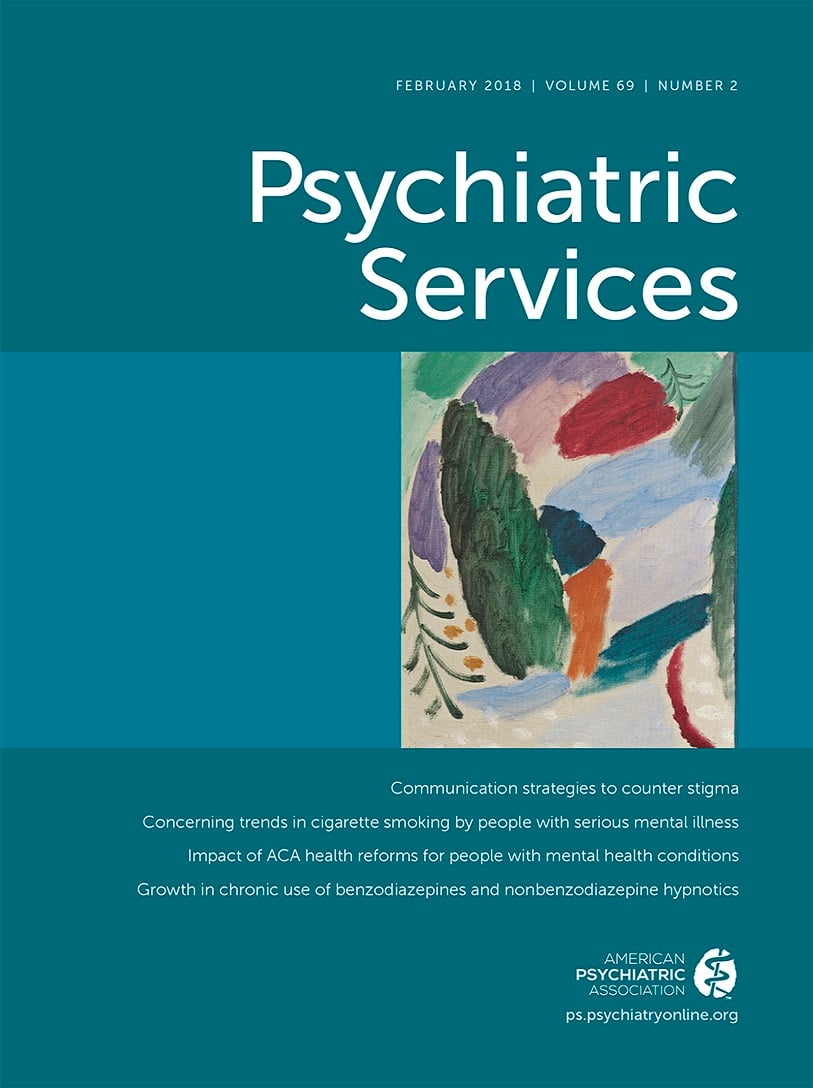Quality and Predictors of Diabetes Care Among Patients With Schizophrenia: A Danish Nationwide Study
Abstract
Objective:
Methods:
Results:
Conclusions:
Methods
The Danish Clinical Registries
The PCRR
Study Population
Individuals with diabetes.
Individuals with diabetes and schizophrenia.
Predictors of Diabetes Care
| Measure | Definitionb |
|---|---|
| Assessment of psychopathology by a specialist in psychiatry | Incident patients who are assessed for psychopathological characteristics by a psychiatrist or specialist clinical psychologist to ensure a valid diagnosis |
| Assessment of psychopathology by interview form | Incident patients who receive a diagnostic interview with an established interview instrument, such as the Schedules for Clinical Assessment in Neuropsychiatry or the Operational Criteria Checklist for Psychotic Illness |
| Assessment of cognitive function | Incident patients who are administered cognitive testing by a psychologist |
| Assessment by a social worker | Incident patients who are assessed for need for social support by a social worker, for example, financial help to purchase medicine or help with changing housing or applying for disability benefits |
| Antipsychotic medical treatment | Patients who are prescribed antipsychotic medical treatment |
| Outpatient antipsychotic medical treatment | Outpatients in medical treatment who are receiving more than one antipsychotic |
| Benzodiazepine medical treatment | Outpatients in medical treatment with benzodiazepines, exclusive of benzodiazepine-related drugs (zolpidem, zopiclone, and zaleplon) |
| Contact with relatives | Staff contact with the patient’s relatives |
| Psychoeducation | Patents who receive psychoeducation |
| Professional support | Patients with a Global Assessment of Functioning score ≤30 who are referred to postdischarge professional support in their own home, a residential facility, or a care home |
| Psychiatric aftercare | Patients who are referred to psychiatric aftercare, including outpatient treatment or contact with a general practitioner or a private specialist after discharge |
| Suicide risk assessment | Patients who are assessed for suicide risk at discharge |
Quality of Diabetes Care
| Measure | Definition |
|---|---|
| Glycemic monitoring | Individuals who have their glycated hemoglobin (HbA1c) level monitored at least once a year |
| Antidiabetic medication | Individuals with type 2 diabetes with HbA1c ≥53 mmol/mol (7%) who are treated with antidiabetic medication |
| Blood pressure monitoring | Individuals who have their blood pressure monitored at least once a year |
| Antihypertensive medication | Individuals with a blood pressure of >140/90 mmHg who are treated with antihypertensive medication |
| Cholesterol monitoring | Individuals over age 30 who have their low-density lipoprotein (LDL) cholesterol monitored at least once every second year |
| Lipid-lowering medication | Individuals with type 2 diabetes over age 40 with LDL cholesterol >2.5 mmol/l who are treated with lipid-lowering medication |
| Screening for albuminuria | Individuals who are screened for albuminuria at least once every second year |
| ACE/ATII inhibitors medication | Individuals with micro- or macroalbuminuria who are treated with angiotensin-converting enzyme (ACE)/angiotensin II receptor (ATII) inhibitors |
| Eye examination I | Individuals receiving an eye examination at least once every second year |
| Eye examination II | Individuals receiving an eye examination at least once every fourth year |
| Foot examination | Individuals receiving a foot examination at least once every second year |
Statistical Analyses
Results
| Diabetes and schizophrenia (N=1,681) | Diabetes only (N=300,957) | |||
|---|---|---|---|---|
| Characteristic | N | % | N | % |
| Sex | ||||
| Female | 688 | 41 | 125,016 | 42 |
| Male | 993 | 59 | 175,941 | 58 |
| Age | ||||
| 18–39 | 423 | 25 | 43,487 | 15 |
| 40–44 | 220 | 13 | 22,144 | 7 |
| 45–49 | 260 | 15 | 25,429 | 8 |
| 50–54 | 260 | 15 | 30,363 | 10 |
| 55–59 | 245 | 15 | 35,377 | 12 |
| ≥60 | 273 | 17 | 144,157 | 48 |
| Diabetes type | ||||
| Type 1 | 423 | 25 | 117,595 | 39 |
| Type 2 | 1,189 | 71 | 174,097 | 58 |
| Other types of diabetes and diabetes without specification | 44 | 3 | 6,175 | 2 |
| Missing | 25 | 1 | 3,090 | 1 |
| HbA1c (mmol/mol) (%) | ||||
| 9–<46 (3–<6.4) | 260 | 16 | 32,895 | 11 |
| 46–<53 (6.4–<7) | 216 | 13 | 45,247 | 15 |
| 53–<64 (7–<8) | 358 | 21 | 90,501 | 30 |
| 64–<75 (8–<9) | 308 | 18 | 67,335 | 22 |
| 75–195 (9–20) | 484 | 29 | 58,802 | 20 |
| Other (<9 and >195) (<3 and >20) | 1 | <1 | 48 | <1 |
| Missing | 54 | 3 | 6,129 | 2 |
| Smoking habits | ||||
| Smoker | 909 | 54 | 69,571 | 23 |
| Smoking occasionally | 16 | 1 | 5,178 | 2 |
| Previous smoker | 213 | 13 | 70,789 | 23 |
| Nonsmoker | 392 | 23 | 125,295 | 42 |
| Missing | 151 | 9 | 30,124 | 10 |
| Body mass index (kg/m2) | ||||
| >0–<20 | 37 | 2 | 9,065 | 3 |
| 20–<25 | 270 | 16 | 73,199 | 24 |
| 25–<30 | 442 | 26 | 98,330 | 33 |
| 30–<50 | 808 | 48 | 106,619 | 35 |
| 50–100 | 40 | 3 | 1,949 | 1 |
| Other (≤0 and >100) | 0 | — | 4 | <1 |
| Not relevant | 23 | 1 | 3,633 | 1 |
| Missing | 61 | 4 | 8,158 | 3 |
| Percentage of relevant diabetes performance measures received | ||||
| 0–<20% | 184 | 13 | 26,503 | 10 |
| 20–<40% | 28 | 2 | 2,859 | 1 |
| 40–<60% | 88 | 6 | 13,251 | 5 |
| 60–<80% | 198 | 13 | 34,055 | 12 |
| 80%–100% | 956 | 66 | 197,412 | 72 |
| Diabetes and schizophrenia (N=1,681) | Diabetes only (N=300,957) | Unadjusted analysis | ||||
|---|---|---|---|---|---|---|
| Variable | N | % | N | % | RR | 95% CI |
| High overall quality of careb | 956 | 66 | 197,412 | 72 | .91 | .88–.95 |
| Individual measure | ||||||
| Glycemic monitoring | 1,227 | 96 | 241,955 | 97 | .98 | .96–1.00 |
| Antidiabetic medication | 321 | 98 | 48,533 | 98 | 1.00 | .99–1.02 |
| Blood pressure monitoring | 1,178 | 93 | 234,424 | 95 | .98 | .96–.99 |
| Antihypertensive medication | 86 | 66 | 28,228 | 80 | .83 | .70–.97 |
| Cholesterol monitoring | 1,108 | 94 | 221,457 | 95 | .99 | .97–1.01 |
| Lipid-lowering medication | 38 | 70 | 7,161 | 64 | 1.09 | .89–1.35 |
| Screening for albuminuria | 1,108 | 88 | 221,920 | 91 | .96 | .93–.99 |
| ACE/ATII inhibitors medicationc | 27 | 59 | 7,656 | 82 | .72 | .55–.93 |
| Eye examination Id | 1,075 | 86 | 214,593 | 88 | .97 | .94–.99 |
| Eye examination IIe | 1,155 | 92 | 226,515 | 93 | .99 | .96–1.01 |
| Feet examination | 1,097 | 87 | 220,702 | 91 | .96 | .93–.99 |
Discussion
Strengths and Limitations
Comparison With Previous Studies
Conclusions
Supplementary Material
- View/Download
- 30.39 KB
References
Information & Authors
Information
Published In

Cover: Frosty Day, by Alexej von Jawlensky, 1915. Oil on paper on cardboard; 10½ by 14 inches. Gift of Benjamin and Lillian Hertzberg, National Gallery of Art, Washington, D.C.
History
Keywords
Authors
Competing Interests
Metrics & Citations
Metrics
Citations
Export Citations
If you have the appropriate software installed, you can download article citation data to the citation manager of your choice. Simply select your manager software from the list below and click Download.
For more information or tips please see 'Downloading to a citation manager' in the Help menu.
View Options
View options
PDF/EPUB
View PDF/EPUBLogin options
Already a subscriber? Access your subscription through your login credentials or your institution for full access to this article.
Personal login Institutional Login Open Athens loginNot a subscriber?
PsychiatryOnline subscription options offer access to the DSM-5-TR® library, books, journals, CME, and patient resources. This all-in-one virtual library provides psychiatrists and mental health professionals with key resources for diagnosis, treatment, research, and professional development.
Need more help? PsychiatryOnline Customer Service may be reached by emailing [email protected] or by calling 800-368-5777 (in the U.S.) or 703-907-7322 (outside the U.S.).
